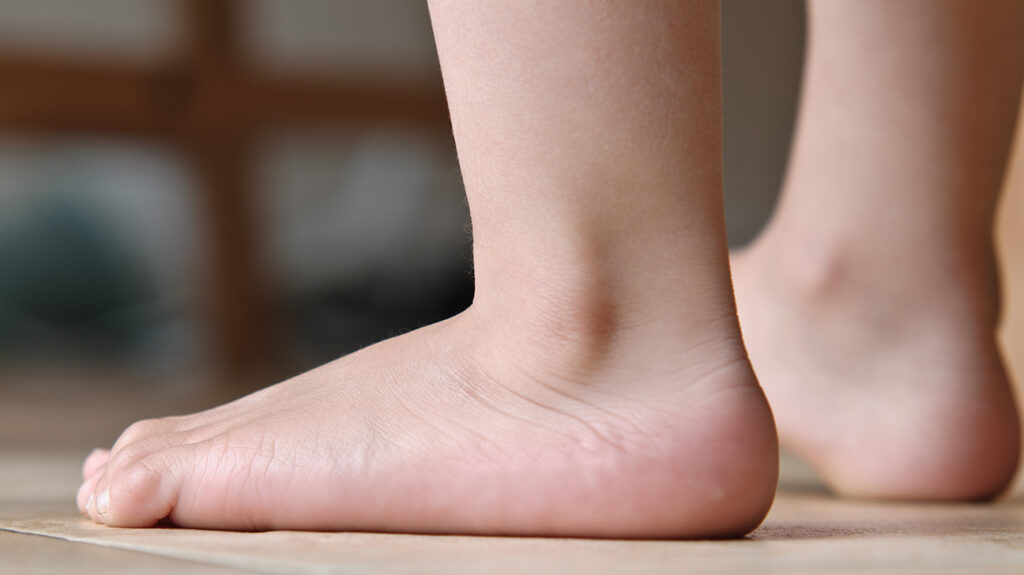Are Flat Feet Hereditary?

The condition known as flat feet is caused by a lack of arches. Also known as a sagging arch, this condition is evident when the feet are flat and there is no gap between the feet and the floor. A question that is often asked is whether a person is born with flat feet or is it a developmental issue. Read on to find out are flat feet hereditary?
Table of Contents
What Are Flat Feet?
Flat feet are those in which the arches of the feet are sunken and the soles of the feet almost completely touch the ground. About 20-30% of the population usually have flat feet because their arches never form during the growth process.
Conditions and Questions:
- Flat feet make running or walking difficult due to the pressure on the ankles.
- Alignment – The overall alignment of the leg may be disrupted as the inward movement of the ankle can cause severe discomfort.
- Knee – If you have complications in your knee, flat feet can lead to arthritis in that area.
Symptom
- pain around the heel or arch
- Difficulty standing on tiptoe
- Swelling of the inside of the ankle
- One or both feet looking up
- Feeling uneven when wearing shoes
What Causes Flat Feet?

Flat feet occur when the raised structure on the inside of the foot (called the medial arch) is particularly low. This is common in children when the medial arch is still developing. By puberty, the arch is more complete. In most cases, flat feet resolve on their own. But for some people, the medial arch never fully develops or may collapse later in life.
Are Flat Feet Hereditary?
Scientists have found that a genetic variant may make some people more prone to flat feet than others. Injury, obesity, and certain health conditions may be linked to flat feet, a study suggests.
Being Born with Flat Feet
Typically, babies are born with flat feet. This condition, called “flexible flat feet,” begins to disappear when the child begins to stand and move. In most cases, children get rid of the disease without treatment, usually by the age of six, as they begin to form arches naturally. About two in ten children will go on to have flat feet as adults.
“Stiff flat feet” are the result of a birth defect or an abnormal connection between the bones of the foot (the tarsal syndesmosis). This condition can be painful, causing tendon spasms, difficulty moving the foot up and down or side to side, and the inability to perform activities such as running and jumping. Left untreated, rigid flat feet can lead to arthritis as well as excessive stress on other parts of the foot.
Developing Flat Feet
Flat feet can sometimes be caused by tightness in the Achilles tendon (the powerful fibrous cord that connects the calf muscle at the back of the leg to the back of the calcaneus), which restricts the movement of the foot. Treatment includes physical therapy to stretch and lengthen the tendon.
Those who have suffered other types of injuries may develop flat feet, for example, by wearing shoes that are not sufficiently supportive or barefoot. Excessive weight bearing can also cause arches to fall; such as being overweight or obese, or during pregnancy.
Flat Foot Treatment

Unless flat feet are a direct result of severe pain or other foot, ankle, and leg abnormalities, there’s not much reason to worry. However, if you are facing pain, there are treatment options for people of all ages.
Child:
The first step in treating flat feet in children is to have them examined. Children do not adjust to such problems as adults do, so parents and caregivers should monitor the proper development of their arches in early childhood. If any abnormalities are found, the child should be examined immediately by our podiatrist.
Most cases of flat feet in children are hereditary. However, their scripts are inherently flexible and can be treated with:
- custom insoles
- support
- suitable shoes
- sports
- Surgery – is often the best treatment to prevent future major developmental complications
Adults
Non-surgical treatment options to stop the development of flat feet and their symptoms include:
- custom orthotics
- support and support
- support shoes
- practice
- Physiotherapy
- weight loss
- Modification of daily activities
- drug
- rest
If non-surgical treatments do not relieve the pain and problems associated with flat feet, surgery may be the next option. Advanced foot and ankle podiatrists always consider conservative treatment options first but are experienced in many surgical options for treating flat feet.
Summary
The fact is that flat feet are heritable, which means they can be passed on from generation to generation like any other gene-driven disease.
Tags: Flat Feet, Hereditary